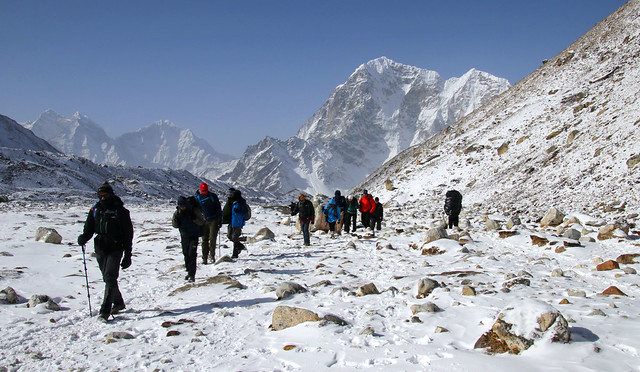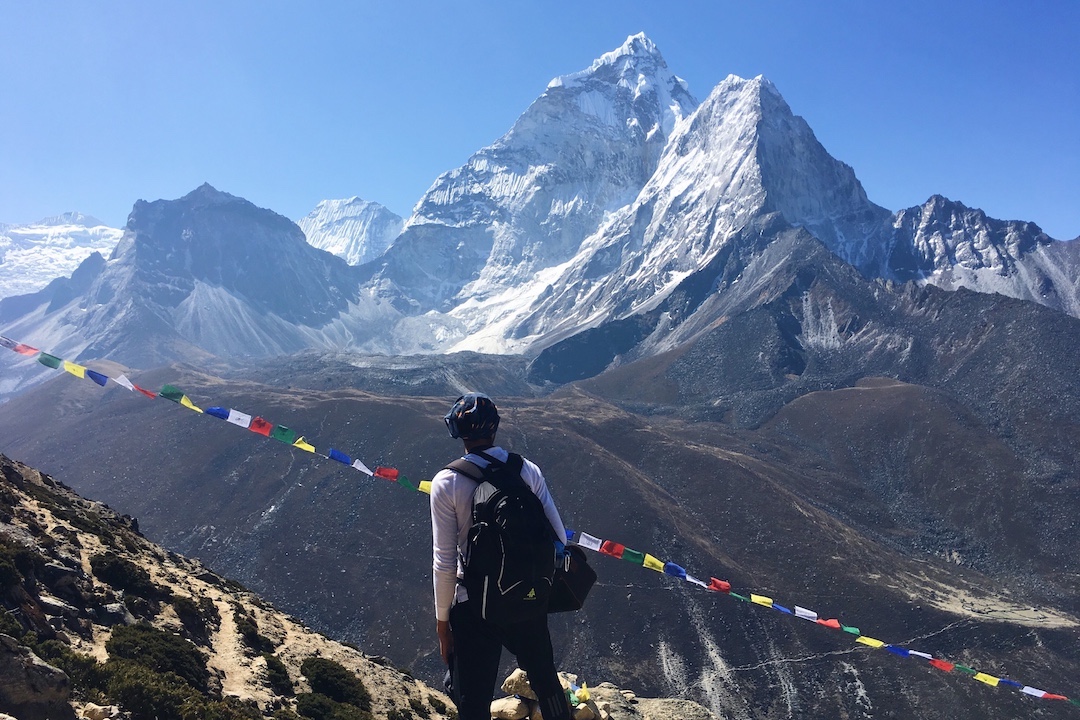Perhaps you long to know what it feels like to be in one of the greatest mountain ranges in the world, the Himalayas? Or maybe you’ve climbed Kilimanjaro, you’ve been to Everest Basecamp (EBC), and now you’re looking for the next adventure. Whether you’re training to get to the top of Mount Everest and Lhotse yourself, or just hoping to see the beauty of those soaring heights with your naked eye, there are lots of peaks that will give you a taste of beginner mountaineering in Nepal.
Nepal climbing season
The first thing to consider is when to climb. Nepal actually has two main climbing seasons, and while tour groups operate outside of these times as well, it’s better to climb during the recommended months as the conditions are ideal. When trying to reach the summit of the Nepalese Himalayan mountains (or any for that matter), you need to give yourself the best chance possible. Even for some of these beginner mountains, weather can impact whether you can go for your summit push or not.

Nepal’s climbing seasons:
- March to early May: Warm days make for warmer nights. While the afternoons can get cloudy, making it hard to see those incredible panoramas, the mornings are incredibly clear and you’ll wake up to pristine views of the Himalayas.
- September to November: Autumn is one of the best times to climb in Nepal. The nights can feel a little chilly, but the clear skies make for some incredible trekking conditions. You’ll definitely see more travellers on the routes, but it’s one of the best times to be in the Himalayas.
- Shoulder months: Late February, late May, and December. If you’re worried about crowds, things are a little quieter during these months. Late February is when the snows clear and the trails begin to stir again. By late May and early December, the climbing season is buzzing but winding down. You’ll see many expeditions on their way back from the summits of Mount Everest.
It’s important to keep in mind that some of the beginner peaks may not be accessible throughout the entire season. Sometimes snow may not clear early enough for the high-altitude porters to fix ropes on certain mountains. Conditions in the Himalayas are unpredictable, but that’s just part and parcel of climbing in this epic mountain region.
Nepal mountain climbing: beginner’s guide
While these summits are for beginners – it’s a relative term. Trekking for days at a time requires you to be in peak condition no matter what level you are doing it at.
Most of the beginner mountains in Nepal involve aspects of technical climbing and require you to have some experience of basic skills: use of crampons, an ice axe, and abseiling. However, you will be given a chance to train with technical equipment during the trek.

You’ll need to get a guide, secure permits and ensure you have the correct gear. The best way to manage all of this is to book with a reputable tour company that has expert experience and knowledge of trekking in the Himalayas.
Having said that, here are the best mountains for beginner mountaineering in Nepal.
1. Kala Patthar
Kala Patthar is not technically a mountain, it’s more of a viewpoint. However, it’s an excellent way to test yourself at altitude for the first time. This notable landmark sits at 5643m above sea level. What makes it really popular is the fact that it provides one of the best spots from where to see the peaks of Mount Everest, Nuptse and Changse.

Because access to the trail for Kala Patthar is in Gorak Shep (the final stop before EBC), a lot of EBC trekking packages also include the hike to Kala Patthar. Depending on your fitness levels, the actual trail to Kala Patthar and back only takes a few hours, but getting to Gorak Shep will take you anywhere between 7-10 days. It’s best to go slowly and not rush acclimatisation. If you’ve never done high-altitude trekking before, and hoping to get into it, you can kick off your beginner mountaineering in Nepal on an EBC and Kala Patthar trek.
2. Mera Peak
Sitting at an elevation of 6476m, Mera Peak is one of Nepal’s highest trekking peaks. Trekking peaks are mostly non-technical, so potentially this is one of the highest climbs that a beginner mountaineer with good fitness can do in the Himalayas without the need for technical skills. Only a small portion of the climb requires the use of crampons, fixed rope and an ice axe. After tackling EBC and Kala Patthar, for beginners that want to get a taste of tackling bigger climbs in the Himalayas, Mera Peak is a true starting point.
3. Pokalde
If you want to know what it feels like to stand at the top of a summit in the Himalayas, Pokalde is one of the best places for that. Located southwest of Mount Everest, it’s one of the easiest and shortest mountain treks in the region and comes with exceptional views of the Himalayas. You climb up to 5806m and gain valuable trekking experience.
Another benefit to choosing this as your first beginner peak is that you will use technical climbing equipment. Parts of the 650m climb from basecamp require some scrambling and the use of a rope close to the summit gives beginners a training ground to start honing their trekking skills.
4. Island Peak
After tackling Pokalde and Kala Patthar, you might be looking for slightly more of a challenge. A place to build on the foundation you are laying down, for which Island Peak (Imja Tse) is perfect. Your elevation gain will be 6189m and once again, you’ll be climbing in the Khumbu region of Nepal.

Imja Tse is great progression peak where you can grow confidence in your mountaineering skills. Beginners learn how to use fixed ropes, ladders, crampons and an ice axe, all while experiencing the challenges and rewards of mountain climbing in the Himalayas. You’ll trek through valleys with panoramic views of Everest, Nupse, Lhotse, and Ama Dablam, stay in sherpa villages and encounter Himalayan mountain culture.
In order to succeed in getting to the summit of Imja Tse, you’ll need to be fit and have established experience of using an ice axe, ropes, and crampons.
5. Lobuche East
Once you have established basic mountaineering techniques, it’s time to turn your sights towards monoliths like Lobuche East. Although it’s not as high as Imja Tse, Lobuche East is considered tougher to climb. It has an elevation of 6119m, and once again, you’ll need to be in good physical shape and able to use crampons, an ice axe and fixed ropes.

What’s great about climbing Lobuche is you get to experience all the challenges of ascending a 6000er in a short period of time. From basecamp, it takes three days to reach the top, giving beginner mountaineers a real taste of alpine conditions and camping. The trek is breathtaking, ascending through the upper Khumbu Valley, you’ll get some insane views of the lofty Himalayas.
Have we inspired you to take your climbing to the next level? Find the best Nepal trekking companies here.


